 Return to
Return toAviation Answer-Man
Gateway
 Return to
Return to
Aviation Answer-Man
Gateway
 Return to
Return to.
Chapter 4
The
Piper Cub
and its many offspring
Copyright 2000, 2001, 2002 by Richard Harris
All Rights Reserved
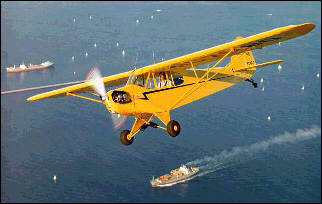 The Piper Cub is the second-most-important American airplane of all time, after the Douglas DC-3. The lowly, cheap little Cub virtually created personal aviation, trained more pilots than any other airplane in history (with the arguable exception of the Cessna 150), pioneered countless new uses for the airplane, and arguably was the most influential American airplane in the Second World War (no kidding).
The Piper Cub is the second-most-important American airplane of all time, after the Douglas DC-3. The lowly, cheap little Cub virtually created personal aviation, trained more pilots than any other airplane in history (with the arguable exception of the Cessna 150), pioneered countless new uses for the airplane, and arguably was the most influential American airplane in the Second World War (no kidding).
 Born at about the same time as the Great Depression, the Cub started as a product of C.Gilbert and Gordon Taylor (left), sons of a mechanically astute British-American immigrant, who helped their aeronautical tinkering. However, their original design, the two-seat (side-by-side) Taylor Chummy (shown below, left), suffered from dependence on a big, expensive 90-horsepower radial engine.
Born at about the same time as the Great Depression, the Cub started as a product of C.Gilbert and Gordon Taylor (left), sons of a mechanically astute British-American immigrant, who helped their aeronautical tinkering. However, their original design, the two-seat (side-by-side) Taylor Chummy (shown below, left), suffered from dependence on a big, expensive 90-horsepower radial engine.
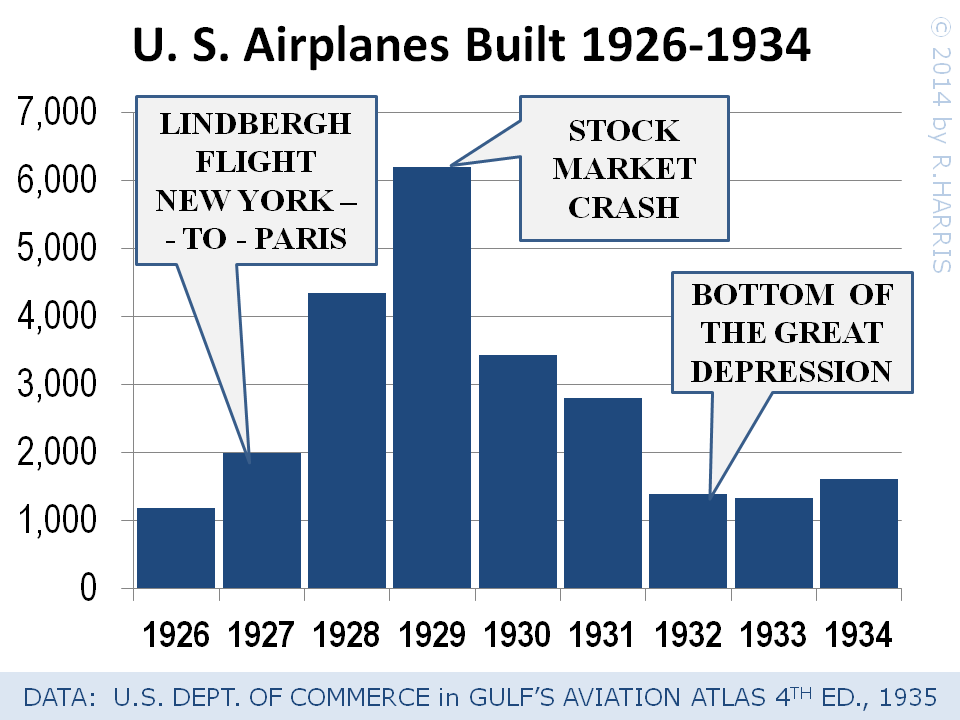
A crash claimed the life of Gordon, and the Great Depression hit, nearly destroying the market for expensive aircraft. The Chummy became hard to sell.
A leading investor in Taylor Brothers Aircraft -- their Treasurer, oilman William T. Piper, Sr. -- urged the survivor, C.Gilbert Tayor, to settle for a smaller, cheaper engine, and to develop a modern, efficient production line, patterned on Henry Ford's successful development in auto manufacturing. Piper envisioned a sort of cheap, everyman's airplane -- and cost-effective trainer. Taylor, on the other hand, continued to envy the high prices commanded by "executive" planes produced by the likes of Bellanca, Stinson, Ryan and Travel Air.

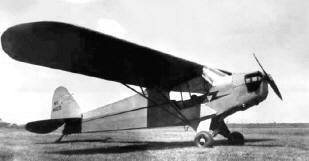
Taylor and Piper argued, as the firm slid into bankruptcy. Slowly coming to grips with the desperate economy of the Great Depression, Taylor finally trimmed down the Chummy into the Model E-2 "Cub", with streamlined tandem seating (one-behind-the-other) and a cheap, little 40-horsepower engine (they first tried a "Tiger Kitten" engine of only 35 horsepower; though it was rejected, it led to the name "Cub" for the plane). While Taylor was out sick, Piper let a young, freelancing, self-styled "aeronautical engineer" -- Walter Jamoneau -- tweak the Taylor design into a functional, efficient, affordable plane: the J-2 Cub (shown at right). Taylor got mad over being bypassed in the development, and eventually quit -- selling Piper his rights to the Cub design and the remaining company assets.
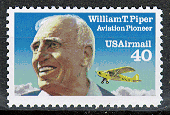 Taylor went off to make Cub-sized planes, but with side-by-side seating more in keeping with his original "Chummy" vision, under the name "Taylorcraft." -- while Bill Piper and his Cub (right) became fabulously successful, with the a refined, 50-horsepower (later 65-horsepower) J-3 Cub version (below). The J-3 Cub would quickly revolutionize aviation, at home and abroad.
Taylor went off to make Cub-sized planes, but with side-by-side seating more in keeping with his original "Chummy" vision, under the name "Taylorcraft." -- while Bill Piper and his Cub (right) became fabulously successful, with the a refined, 50-horsepower (later 65-horsepower) J-3 Cub version (below). The J-3 Cub would quickly revolutionize aviation, at home and abroad.
 While almost every aviation company crashed in the Great Depression, Piper soared, selling hundreds of his tiny, yellow airplanes (they only came in yellow). Cheap as a good car, rather slow (60 miles per hour, typically), but gentle and reliable, the Cub became -- as Piper had hoped -- the "everyman's airplane." Despite the nation suffering from the greatest economic depression in its history, the affordable Piper Cub became the first American airplane truly popular (and mass-produced) for purely personal flying. (Some experts would give that credit to the slightly older Aeronca C-2 "flying bathtub," but it was nowhere nearly as popular as the Piper Cub, in the long run, nor nearly as influential.)
While almost every aviation company crashed in the Great Depression, Piper soared, selling hundreds of his tiny, yellow airplanes (they only came in yellow). Cheap as a good car, rather slow (60 miles per hour, typically), but gentle and reliable, the Cub became -- as Piper had hoped -- the "everyman's airplane." Despite the nation suffering from the greatest economic depression in its history, the affordable Piper Cub became the first American airplane truly popular (and mass-produced) for purely personal flying. (Some experts would give that credit to the slightly older Aeronca C-2 "flying bathtub," but it was nowhere nearly as popular as the Piper Cub, in the long run, nor nearly as influential.)
Cheap to buy, efficient to operate, versatile, sturdy, gentle and reliable -- compared to much of its competition -- the Cub quickly became the most popular new airplane in America -- and eventually in the world. As its cost-efficient popularity grew, the Cub quickly became the cheap, all-purpose utility airplane, and personal flying machine.

The Cub as Tutor:
Becoming the greatest pilot-trainer in history
Most planes do well to stay in the air as slow as 45-50mph, but the Cub's thick, "slow-speed" wing made it possible for the Cub to be flown as slowly as 38 miles per hour, permitting slow-and-safe landings, often giving the pilot time to quickly work his way out of an accidental stall before crashing.
Low landing speeds, and sturdy landing gear gave the Cub the ability to operate safely from simple, tiny grass strips almost anywhere -- particularly valuable in a time when regular airports were few and far between. The gentle, cheap-to-buy, cheap-to-fly Cub also made flight training far more affordable. The Cub quickly became popular for training pilots, and the cheap, gentle Cub made flight training more practical and inviting -- causing thousands more people to become pilots..
 With war gathering on the horizon in Europe and Asia, the U.S. government started the Civilian Pilot Training Program (CPTP) to prepare thousands of young Americans as pilots for the inevitable U.S. military involvement. By the time America joined the war, over 50,000 pilots had been trained -- most in Piper Cubs. (A pilot-training center, with dozens of Cubs, is shown at left.) Various expert sources have estimated that betwen 60% to 80% of all U.S. military pilots in World War II learned to fly in a Cub. All the famous American warplanes of the Second World War -- fighters, bombers, transports and others -- might have been largely un-piloted and useless, were it not for the prior proliferation of the Piper Cub. Although its military-pilot training role was eventually eclipsed by other aircraft (particularly Stearman biplanes), the Cub remained the "birthplace of pilots" well into the war.
With war gathering on the horizon in Europe and Asia, the U.S. government started the Civilian Pilot Training Program (CPTP) to prepare thousands of young Americans as pilots for the inevitable U.S. military involvement. By the time America joined the war, over 50,000 pilots had been trained -- most in Piper Cubs. (A pilot-training center, with dozens of Cubs, is shown at left.) Various expert sources have estimated that betwen 60% to 80% of all U.S. military pilots in World War II learned to fly in a Cub. All the famous American warplanes of the Second World War -- fighters, bombers, transports and others -- might have been largely un-piloted and useless, were it not for the prior proliferation of the Piper Cub. Although its military-pilot training role was eventually eclipsed by other aircraft (particularly Stearman biplanes), the Cub remained the "birthplace of pilots" well into the war.
A New Kind of Airpower:
The Cub L-4 "Grasshopper" in World War II

During the war, too, the Cub found new missions. While big powerful fighters, bombers and transports were valuable and effective tools, they required long runways, and sophisticated maintenance facilities, so they could not operate from primitive fields in forward areas near battle lines. And they were too valuable to be used for many minor missions that could -- nevertheless -- only be performed by airplane. However the Cub, and other various popular, light taildraggers (by Taylor, Stinson, Aeronca, Porterfield and Luscombe) stepped into the breach. These tiny, simple planes could land and take off almost anywhere (this Cub is being "hand-propped" for takeoff from a country road), could be readily serviced in the field, and could carry a modest, but useful, load.
General Eisenhower, supreme commander of the Allies in Europe -- who had learned to fly a Cub -- realized these light planes' value as support aircraft for battlefield ground commanders, and arranged for these tiny "puddle-jumpers" to be assigned as standard equipment to every major ground commander. After a general noticed a green-painted one bouncing "like a grasshopper" on landing, all the Army's different brands of little light planes -- looking much like the Cub -- became known as "Grasshopppers."
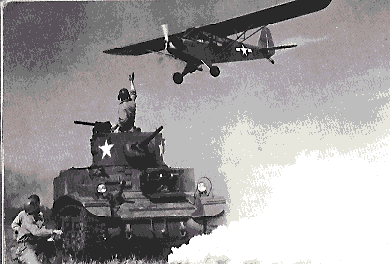 Designed for utility, and refined for affordable mass-production and efficient operation, the Cubs were -- by far -- the most numerous of the Army's "Grasshopper" light planes. Designated as "L-4" liason planes, they provided close-support aviation in combat areas. Flying low, ducking enemy fighters, and dodging ground fire, Grasshopper Cubs were used as a quick transport for essential personnel and cargo, to and from combat areas -- and as aerial observation platforms. They carried blood plasma and medicines into combat zones, and carried wounded soldiers out -- pioneering the concept of aerial "Med-Evac" (medical evacuation). They delivered radios and ammunition, and carried vital secret maps and messages between commanders. They even transported the commanders, themselves.
Designed for utility, and refined for affordable mass-production and efficient operation, the Cubs were -- by far -- the most numerous of the Army's "Grasshopper" light planes. Designated as "L-4" liason planes, they provided close-support aviation in combat areas. Flying low, ducking enemy fighters, and dodging ground fire, Grasshopper Cubs were used as a quick transport for essential personnel and cargo, to and from combat areas -- and as aerial observation platforms. They carried blood plasma and medicines into combat zones, and carried wounded soldiers out -- pioneering the concept of aerial "Med-Evac" (medical evacuation). They delivered radios and ammunition, and carried vital secret maps and messages between commanders. They even transported the commanders, themselves.
Compared to most other light planes, which had side-by-side seating, the narrow, tandem-seat L-4 Grasshopper made it possible for a lone pilot to thoroughly survey the ground directly below him on both sides of the plane at the same time. The L-4B model (shown below) had extra windows extending all around the airplane, for superb visibility. Finally, unlike the fast-and-high fighters that had been used for reconnaisance, the Grasshoppers -- braving enemy fire -- could fly low and slow for a very good look at enemy positions -- while easily ducking behind hills or hedgerows for cover.
The Grasshoppers soon took over the job of scouting the targets for artillery, provided aerial reconnaisance over combat areas, and carried battlefield commanders to superb vantage points from which to plan and direct a battle. The U.S. Navy launched them from ships to guide invasions, and one of the first acts during the "D-Day" invasion of Normandy, upon securing the beachhead, was to prepare a tiny airstrip so that L-4's -- with Stinson L-5 Sentinels -- could be launched to direct the naval and army artillery fire for the move inland.
General Eisenhower, in his memoirs, would write that...

"the cub planes... enabled our heavy and long-range artillery to gain an accuracy and quickness of adjustment previously restricted to the light guns within eyeshot of the target; and field commanders could get a grasp of the tactical situation -- terrain, avenues of movement, concentrations of troops and artillery -- almost as complete as in the 18th century, when the opposing commanders, from horseback or a hillock, could view all the regiments committed to the battle." ("Crusade in Europe, Doubleday & Co., NY, 1948, p.12)
On rare occasions, these "combat Cubs" even attacked enemy troops. As "close-support" aircraft, the L-4 Cubs and other Grasshoppers were so effective at extending the capabilites of ground troops that, at one point, when Nazi commanders offered a bounty to pilots for shooting down big-and-fast Allied fighters -- they gave double bounties for shooting down a "Grasshopper" Cub.
In short, the cheap, plentiful, practical Piper Cub was the airplane most infuential in the development of ground-support combat aviation -- later mostly taken over by the development of the helicopter. What the Cub and its kind started in World War II, as "Army Ground Forces (AGF) Aviation," is known today as simply "Army Aviation" -- employing thousands of helicopters and fixed-wing aircraft alike. For better or worse, the American success with the concept has been copied by countries the world over -- giving a much greater awareness, flexibility and reach to the world's military forces.
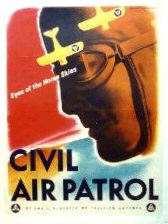
Citizen-Warrior: Civilian Cubs in World War II
The Cub -- along with a variety of other civilian aircraft -- was also one of the chief tools for driving Nazi submarines away from American coastal sea lanes. At the early stages of the war, nearly a hundred American merchant ships had been sunk by German "U-boat" submarines prowling in or near U.S. coastal waters. Hundreds of lives were lost -- not to mention thousands of tons of valuable war supplies -- and the ships that carried them. Under the Civil Air Patrol ("CAP"), Cubs (like the one shown below, in CAP markings) and other small planes -- mostly civilian (of which Cubs were the most numerous) -- were organized to patrol America's coastlines.
The CAP planes' constant presence -- ranging over 100 miles out to sea -- made America's coastal waters too dangerous for German submarines (which had to periodically surface for air). CAP pilots spotted and reported U-boats over 150 times, generally calling for military attack (but occasionally attacking the subs on their own) -- with the result that several enemy subs were sunk, while nearly a hundred Allied ships were saved, or their crews rescued. Eventually, the Nazi U-boats retreated from American waters. After the war, an interrogated German naval commander cursed the "damned little red and yellow airplanes" -- the Cub and its kind -- as the reason that he had pulled his subs back from American shores during the war.
 The CAP, using mostly civilian light planes (particularly Piper Cubs), and civilian pilots (including those not physically fit enough for the military) relieved the military of many essential, non-combat missions: anti-sabotage patrol, target towing (a hazardous task, when facing new gunners), border patrol, and search-and-rescue for pilots and others lost in or near the U.S. By taking over these chores, and hundreds of "messenger missions" and menial errands, the CAP Cubs and other CAP planes began freeing thousands of American military planes for combat, and freed American wartime aircraft production to focus on building planes for combat.
The CAP, using mostly civilian light planes (particularly Piper Cubs), and civilian pilots (including those not physically fit enough for the military) relieved the military of many essential, non-combat missions: anti-sabotage patrol, target towing (a hazardous task, when facing new gunners), border patrol, and search-and-rescue for pilots and others lost in or near the U.S. By taking over these chores, and hundreds of "messenger missions" and menial errands, the CAP Cubs and other CAP planes began freeing thousands of American military planes for combat, and freed American wartime aircraft production to focus on building planes for combat.
After the War: Still Important
The post-war aviation boom depended upon the military pilots from the war -- most of whom had become pilots in Cubs. Consequently, the Piper Cub was not only the most important American plane of World War II, but the most important plane of America's postwar aviation boom: it had trained the pilots who would lead the explosive postwar growth of commercial and general aviation. After the war, the Cub returned to training, and to the development of personal flying. Until the end of the 1950's (the birth of the Cessna 150), the Cub remained the most important trainer aloft.
 As if that were not enough, the Cub was also the most popular postwar personal aircraft for half a decade. The Cub also became the basic plane for post-war barnstorming and aerobatic flying ("aerobatics"). It was also one of the first popular airplanes for agricultural aviation (cropdusting and crop surveying, aerial herding and herd countng, aerial delivery of supplies and feed, and so on). It found its way into countless other utility missions, including pipeline and powerline checking, game warden patrols, aerial land surveying, and banner towing. On pontoon floats, the Cub became the most popular way to train seaplane pilots, for whom it is still a popular trainer.
As if that were not enough, the Cub was also the most popular postwar personal aircraft for half a decade. The Cub also became the basic plane for post-war barnstorming and aerobatic flying ("aerobatics"). It was also one of the first popular airplanes for agricultural aviation (cropdusting and crop surveying, aerial herding and herd countng, aerial delivery of supplies and feed, and so on). It found its way into countless other utility missions, including pipeline and powerline checking, game warden patrols, aerial land surveying, and banner towing. On pontoon floats, the Cub became the most popular way to train seaplane pilots, for whom it is still a popular trainer.
Thanks to its durability, simplicity and affordability to operate and maitain, thousands of Cubs are STILL in active use, all over the earth. In the United States, alone, in 2002, the Federal Aviation Administration reported over 5,000 Piper J-3 Cubs still on the active registry. The very first Cub (a Taylor Brothers Model E-2) is still intact, in the possesion of the New Piper Aircraft Co., Inc., and was flying when they acquired it in the early 1990's. It was over 60 years old. Very few airplane designs have ever achieved such extraordinary longevity in the actual original aircraft.
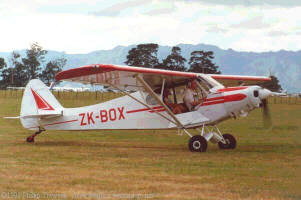 The Immortal Cub:
The Immortal Cub:
more uses,
more kinds of Cubs,
more to come...
Later versions, particularly the SuperCub (a bigger-engined, stronger Cub, still produced intermittently, even today), would expand the Cub's missions, making it one of the most popular utility and bush planes flying today.
Hauling up to a half-ton of fuel, people and cargo, at over 100 miles per hour, the SuperCub (above, left) and its kin are prized as cheap, nimble, sturdy birds, which can land on a dime, and cost only a little more to operate -- bringing the benefits of air service to people and places far-removed from most of civilization. Whether alighting in a forest clearing, perched on a mountain slope, bouncing on pontoon floats in the Amazon jungle, or landing on skis in the Artic tundra (below, right), the Cub is still the classic go-anywhere, do-anything airplane.
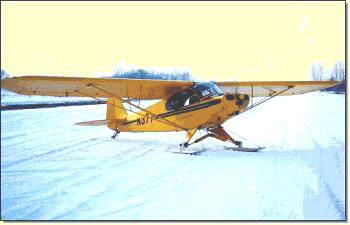 And, for all the reasons that made it popular initially, thousands of Cubs and their offspring -- throughout the world -- are still used as personal, professional, and military flying machines today.
And, for all the reasons that made it popular initially, thousands of Cubs and their offspring -- throughout the world -- are still used as personal, professional, and military flying machines today.
Over 20,000 Cubs and 10,000 of their variants have been built and used since the first one rolled off the assembly line 70 years ago (Spring, 1931). Some models are still in production today -- while a half-dozen companies make popular Cub imitations, or provide kits or plans for eager homebuilders to "roll their own." With over a BILLION miles (1,000,000,000 miles) flown in Cubs, they have brought the benefits of aviaton to more places, in more ways, than any other airplane ever built. Still popular and loved, a generation past its prime, the Cub and its descendants continue as a significant part of general aviation.
In its early years, the Piper Cub stood alone as the first quality airplane affordably-produced, that was widely-available, comparatively safe and useful. And ever since, the Cub has remained a global icon of practical flying. Of all the hundreds of airplane designs in the past century of flight, only the Bleriot XI and the DC-3 can compete with the Cub for the title of "Most Important Civilian Airplane of All Time."
 Why this plane stands out from its "peers."
Why this plane stands out from its "peers."
While many other planes have been important, few others had nearly so pivotal an impact on aviation or on history as the Piper Cub. The Cub (and its variations) are "indispensible"aircraft -- aircraft with no significant concievable substitute available at their juncture in history, and aircraft which helped shape world history.
The Piper Cub, the second-most-important American aircraft of all time, had many competitors: Taylorcrafts, Aeroncas, Porterfields, Luscombes, Stinsons and more. But Bill Piper's shrewd management skills -- exemplified by his sophisticated, efficient, assembly-line manufacturing -- made the Cub a much better buy than anything comparable. And the plane itself was a masterpiece of simplicity and manufacturing efficiency. Besides its exceptional adaptability and versatility, it was also durable and reliable, and required minimal maintenance. Piper's marketing skills, too, were indispensible in getting the unusual national acceptance of the airplane as a personal possession -- in the midst of America's greatest economic catastrophe.
Available in vast numbers, with gentle flying manners and low purchase price and operating costs, the Cubs became the perfect plane around which to build a national pilot-training program, to prepare America for war. The several other competing aircraft, owing in part to their less-efficient engineering and poorer company management, did not exist in anywhere nearly as great a number as the Piper Cub. And some were simply not as well-suited to the needs of flight training. Had the Cub not existed, it would have been indescribably more difficult for America to come up with the 60,000 trained American pilots needed to fight the 60,000 trained pilots of the German Luftwaffe, when war between the two nations began.
But the Piper Cub -- cheap, plentiful and functional -- came through, and by the the first year of real war between America and the Axis powers (Germany, Italy and Japan), the Axis aerial armadas found themselves facing an American aerial army that would soon wear them down, drive the Axis powers from the sky, and rain down defeat upon them.
And this same American aerial army -- first trained in Cubs -- would lead the way for America's massive and decisive post-war aviation boom. .
 But before World War II was over, the agile, durable, versatile, affordable Cub, itself, would give rise to a whole new type of military aviation -- close air support -- which might have initially seemed impractical with almost any other aircraft. Available in huge numbers, inexpensively, ideal for low-and-slow observation, and often able to land and take-off from places that even their best competitors (like Aeroncas and Stinsons) could not fit into, the "Grasshopper" Cubs paved the way for the military concept of truly-close "close air support" -- the primary mission for today's military helicopter.
But before World War II was over, the agile, durable, versatile, affordable Cub, itself, would give rise to a whole new type of military aviation -- close air support -- which might have initially seemed impractical with almost any other aircraft. Available in huge numbers, inexpensively, ideal for low-and-slow observation, and often able to land and take-off from places that even their best competitors (like Aeroncas and Stinsons) could not fit into, the "Grasshopper" Cubs paved the way for the military concept of truly-close "close air support" -- the primary mission for today's military helicopter.
And, with its mass availability in World War II (practical helicopters would not be available until years later), where ground forces were decisive [hardly a fashionable fact in aviation history circles, and consequently underreported], the flexibility and vision afforded them by the Cub provided a significant margin of advantage over enemy ground forces, aiding the Allied victory. By comparison to the plentiful Cub, the Germans' most effective forward support aircraft was the Fieseler Storch -- a more complex and demanding aircraft -- more expensive, and thus comparatively rare, and of limited effect.
Indeed, by virtue of its unique combination of affordability and durability -- and its superb compromise between peformance, practicality and simplicity -- the Piper Cub has been used in more ways, in more places, than any other airplane in history.
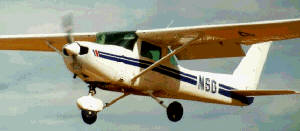
By the early 1960's, the 2-seat, side-by-side Cessna 150 / 152 (shown at right) -- would finally eclipse the Cub as the world's most popular trainer, with over 30,000 Cessna 150 variants built by the end of production in the mid-1980's. Today, over fifteen years out-of-production, the Cessna trainer remains the world's dominant training airplane. The Cessna 150, ultimately, may have trained more pilots around the world than the Piper Cub. But the 150 has arrived at a much later, much-less-critical juncture in aviation history -- and world history. Further, if there were no Cessna 150, there are many adequate (if clearly inferior) substitutes, available at competitive prices -- including thousands of used-but-still-useful Piper Cubs!
| Symbolic of its importance in aviation history, the Piper Cub is the only light plane to be featured on two different U.S. Postage Stamps; the other appears at the start of this article, beside the stamp's honoree, William T. Piper, Sr., who envisioned, produced and promoted the Cub as the basic airplane for the common man. |

|
Finally, the Piper Cub's uniquely widespread recognition, acceptance and importance have been most clearly illustrated by the fact that -- for decades after its invention -- the non-aviation public, around the world, commonly applied the term "Piper Cub" to almost any small airplane they saw -- virtually making the brand name "Piper Cub" the world's generic synonym for "light plane."
 Return to
Return to
Eight Great Aircraft
starting page